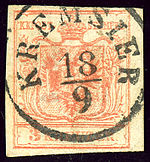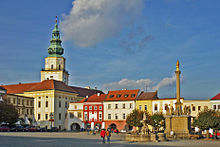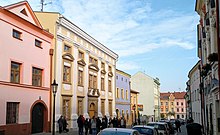Kroměříž
| Kroměříž | ||||
|---|---|---|---|---|
|
||||
| Basic data | ||||
| State : |
|
|||
| Historical part of the country : | Moravia | |||
| Region : | Zlínský kraj | |||
| District : | Kroměříž | |||
| Area : | 5561 ha | |||
| Geographic location : | 49 ° 18 ' N , 17 ° 24' E | |||
| Height: | 201 m nm | |||
| Residents : | 28,816 (Jan 1, 2019) | |||
| Postal code : | 767 01 | |||
| License plate : | Z | |||
| traffic | ||||
| Railway connection: |
Kojetín – Hulín Kroměříž – Zborovice |
|||
| structure | ||||
| Status: | city | |||
| Districts: | 10 | |||
| administration | ||||
| Mayor : | Jaroslav Němec (as of 2014) | |||
| Address: | Riegrovo nám. 149 76758 Kroměříž |
|||
| Municipality number: | 588296 | |||
| Website : | www.mesto-kromeriz.cz | |||
Kroměříž ['kromɲɛr̝iːʃ] (German Kremsier ) is a town in the district of the same name in the Zlín region in East Moravia , Czech Republic . It is located immediately south of the confluence of the Haná and Moštěnka in the March . In 1997 Kremsier, whose city center is under monument protection, was voted the most beautiful historical city in the Czech Republic. Because of its historical, cultural and political importance, it was nicknamed "Athens of the Hanna region ".
history
The origins of the settlement go back to the time of the Great Moravian Empire . Kremsier was first mentioned as a village in 1110 when it was acquired by the Olomouc bishop Johannes II . Because of its location at the intersection of several trade routes, it was able to develop rapidly and is referred to as a market town in 1207 . Around 1266, at the suggestion of Bishop Bruno von Schauenburg , who had a castle built around this time, it was raised to the status of a town by King Přemysl Otakar II. In 1290, Bishop Dietrich von Neuhaus gave Brno town charter .
During the Hussite Wars , Kremsier was conquered in 1423 and 1432 and was considered the most radical Hussite city in Moravia. Subsequently, the owners changed several times, from whom the city was also pledged. It was not until 1456 that Kremsier was returned to the Olomouc bishopric.
1465–1471 Kremsier was the center of the armed conflicts between the Bohemian King George of Podebrady and the Hungarian King Matthias Corvinus , which could not be settled until 1479 in the Peace of Olomouc . At the beginning of the 16th century, Kremsier became the main residence of the Olomouc bishops under Bishop Stanislaus Thurzo , who had the Gothic castle converted into a Renaissance castle. Under the Olomouc bishops, Jan Pivec von Hratschein and Klimstein was captain of the city at the end of the 16th century. Under the bishops Wilhelm Prusinovský and Stanislaus Pavlovský , the town became prosperous, which made it an important political and cultural center of the Margraviate of Moravia .
In the Thirty Years' War Kremsier was completely destroyed after it was captured by General Lennart Torstensson . It was not until Bishop Karl II of Liechtenstein-Kastelkorn came to power that the city experienced an economic boom. He rebuilt the city, had roads, water pipes and sewers built, built the episcopal residence and founded a Piarist high school .
During the War of the Austrian Succession , Kremsier was occupied by the Prussian army in 1742 and hit by fire in 1752. It had to endure a new occupation in 1805 during the Napoleonic Wars .
In 1887 Ignac Lorenz founded the machine factory Lorenz, which mainly manufactured agricultural machines until the nationalization in 1948.
The city gained historical importance in the autumn of 1848. After the bloody suppression of the October Uprising in Vienna , the constituent Reichstag was moved to Kremsier and opened on November 22nd in the meeting room of the Archbishop's Palace. The Reichstag drew up a draft constitution that was supposed to convert the Habsburg monarchy into a federal state . However, Emperor Franz Joseph and his Prime Minister Felix Fürst zu Schwarzenberg ignored the Kremsier draft , instead introduced the October Constitution and dissolved the Reichstag on March 7, 1849 with military help.
In 1885 Emperor Franz Joseph and Tsar Alexander III met in Kremsier . for political talks.
In the 20th century, the population increased sharply through the incorporation of the surrounding villages.
coat of arms
The city coat of arms of Kroměříž shows the family coat of arms of the noble family Dietrichstein , which was wealthy locally.
Attractions
The historic city center was declared an urban monument reserve in 1978 .
- At the main square (Velké náměstí) :
- The Archbishop's Palace was added to the UNESCO World Heritage List in 1998.
- Town houses with Gothic arcades and baroque gables, some with sgraffito decoration .
- Renaissance town hall from 1611.
- Baroque fountain from 1655.
- Marian column, erected after the plague of 1680.
- Trinity column from 1686 ( Riegrovo náměstí) .
- The St. Mauritius Church (chrám sv. Mořice) from the 13th century is the oldest church in the city.
- Piarist Church of St. John the Baptist (chrám sv. Jana Křtitele) .
- Church of the Blessed Virgin Mary (chrám Blahoslavené Panny Marie) .
- Archbishop's coin from 1665.
- City Museum.
- About 500 meters west of the main square is the flower garden (Květná zahrada) , which was designed in 1665–1675 by Filiberto Lucchese and Giovanni Pietro Tencalla based on the Versailles model with grottos, labyrinths and a pavilion. The west side of the garden is bordered by a 233 m long colonnade with statues of ancient gods.
- The Kroměříž chateau park
Personalities
sons and daughters of the town
(The following personalities were born in Kroměříž. They are listed chronologically by year of birth. It does not take into account whether or not they later had their sphere of activity in Kroměříž.)
- Johannes Milicius (* between 1320 and 1325, † 1374), Bohemian preacher
- Maximilian Freiherr Mayer von Wallerstain and Ahrdorff (1845–1928), Roman Catholic clergyman and poet
- Max Švabinský (1873–1962), painter and graphic artist
- Hermann Pokorny (1882–1960), Austro-Hungarian cryptanalyst
- Max Spielmann (1881–1970), architect
- Václav Talich (1883–1961), conductor and violinist
- Jan Rypka (1886–1968), orientalist, translator and holder of the chair in Iranology and Turkology at Charles University in Prague
- Robert Land (1887–1939?), Czech-Austrian film director
- Josef Silný (1902–1981), Czech football player
- Alexej Čepička (1910–1990), Czechoslovak politician
- Walter Staffa (1917–2011), German expellee functionary
- Jaroslav Koutecký (1922–2005), Czech physicist
- Karel Prager (1923–2001), Czech architect
- Miloš Macourek (1926–2002), Czech author
- Josef Karlík (1928–2009), Czech actor
- Milan Pitlach (* 1943), Czech architect and photographer
- Karel Kryl (1944–1994), Czech singer
- Michal Peprník (* 1960), Czech Americanist
- Pavel Hapal (* 1969), Czech football player
- Pavel Novotný (* 1973), Czech football player
- Tomáš Netopil (* 1975), Czech conductor
- Jaromír Paciorek (* 1979), Czech football player
- Šárka Nakládalová (* 1985), Czech beach volleyball player
- Gabriela Gunčíková (* 1993), Czech singer
- Filip Chytil (* 1999), Czech ice hockey player
Worked in place
(The listing is alphabetical.)
- Břetislav Bakala , Czech conductor, choir director and composer, attended high school here;
- Heinrich Ignaz Franz Biber , violinist, was in the service of Bishop Karl Liechtenstein-Kastelkorn from 1668 to 1670;
- Karel Leopold Klaudy , Czech lawyer and politician, here member of the Reichstag until its dissolution;
- Pavel Josef Vejvanovský (around 1633–1693), Bohemian composer, trumpeter and conductor at the summer residence of the Olomouc prince-bishops in Kremsier.
Stumbling blocks
So far, five stumbling blocks have been laid in Kroměříž for Jewish citizens murdered by Nazi persecution - for Emil Brand and the rabbi in Kroměříž, Joachim Astel , and three other members of his family. The last relocation took place on November 6, 2017. During the time of the Protectorate of Bohemia and Moravia , a total of 259 Jews were deported to concentration camps and murdered in the city.
Districts
(Status: 2001)
- Bílany (German Bielan ); 93 houses, 292 inhabitants
- Drahlov ( Eng . Drahlow ); 48 houses, 127 inhabitants
- Hradisko (Eng. Hradisko ); 83 houses, 221 inhabitants
- Kotojedy ( Eng . Kottoged ) (52 houses, 126 inhabitants)
- Kroměříž (German Kremsier ); 3532 houses, 25,826 inhabitants
- Postoupky (German Postupek ); 202 houses, 558 inhabitants
- Těšnovice (German: Tischnowitz ); 137 houses, 412 inhabitants
- Trávník ( Ger . Trawnik , older Traunitz ); 131 houses, 392 inhabitants
- Vážany (German Washan ); 289 houses, 1,128 inhabitants
- Zlámanka (German Zlamanka ); 72 houses, 143 inhabitants
Community partnerships
Kroměříž has partnerships with the following cities and municipalities:
- Châteaudun , France
- Nitra , Slovakia
- Krems an der Donau , Austria
- Piekary Śląskie , Poland
- Râmnicu Vâlcea , Romania
literature
- Joachim Bahlcke , Winfried Eberhard, Miloslav Polívka (eds.): Handbook of historical places . Volume: Bohemia and Moravia (= Kröner's pocket edition . Volume 329). Kröner, Stuttgart 1998, ISBN 3-520-32901-8 .
- Erhard Gorys : Czech Republic. Culture, landscape and history in Bohemia and Moravia (= DuMont documents. DuMont art travel guide ). DuMont, Cologne 1994, ISBN 3-7701-2844-3 .
- Dagmar Glüxam: Kremsier. In: Oesterreichisches Musiklexikon . Online edition, Vienna 2002 ff., ISBN 3-7001-3077-5 ; Print edition: Volume 3, Verlag der Österreichischen Akademie der Wissenschaften, Vienna 2004, ISBN 3-7001-3045-7 .
- Marianne Mehling (Ed.): Knaur's cultural guide in color Czech Republic, Slovak Republic. Droemer Knaur, Munich 1993, ISBN 3-426-26609-1 .
Individual evidence
- ↑ Český statistický úřad - The population of the Czech municipalities as of January 1, 2019 (PDF; 7.4 MiB)
- ↑ http://de.forvo.com/word/kroměříž/#cs ; the speaker Skypi comes from the north of the Czech Republic, Frosty from the southeast, where Kroměříž is also located
- ↑ Dlažební kostky v Kroměříži připomínají oběti nacistického tažení proti Židům , report of the Czech Radio, online at: rozhlas.cz / ...
- ↑ Jan Vondrášek: Kroměříž uctí památku posledního městského rabína a jeho rodinykomy zmizelých , portal of the town of Kroměříž, online at: mesto-kromeriz.cz / ... ( Memento from February 9, 2018 in the Internet Archive )
- ↑ http://mapy.mzk.cz/mzk03/000/907/223/2619267510/
Web links
- Official site of the city
- Kroměříž Castle
- Kremsier and the Archbishop's Palace - a contribution by the church historian Rudolf Grulich






